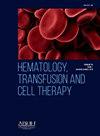A CASE OF THROMBOTIC THROMBOCYTOPENIC PURPURA RELATED TO MALIGNITY AND CHEMOTHERAPY
IF 1.8
Q3 HEMATOLOGY
引用次数: 0
Abstract
Objective
Thrombotic thrombocytopenic purpura (TTP) is a life-threatening multisystem disease. TTP progresses with Microangiopathic hemolytic anemia (MAHA), fever, thrombocytopenia, neurological symptoms, and renal failure. Due to microangiopathic hemolytic anemia, schistocytes are seen in the peripheral blood smear, resulting in thrombocytopenia. Damage to the brain and kidneys occurs due to microvascular thrombosis, and this is how symptoms appear. In pathogenesis, it is caused by the deficiency of ADAMTS 13 (a disintegrin and metalloproteinase with thrombospondin type 1 motif, member 13), which breaks down the von Willebrand factor (VWF) found in the endothelium into multimers, or the development of antibodies against it. Due to ADAMTS 13 deficiency or decrease in its activity, VWF cannot be separated into small pieces and is arranged in large pieces in the endothelium, causing widespread intravascular thrombosis. Many factors can be considered as triggers for the development of TTP, such as pregnancy, malignancy, medications, and autoimmune diseases.
Case Report
A 59-year-old female patient was admitted due to thrombocytopenia, epileptic seizure, hematemesis and decreased consciousness while being followed up due to cholangiocellular carcinoma. Due to malignancy, 6 cycles of gemcitabine and carboplatin treatment were applied. The last cure was 6 months ago. In followers, WBC 3.24 10^3/uL (3.7-10 10^3/uL), Hbg 8g/dL(12.9-14.2 g/dL), MCV 84 f/L(81-96fL), platelet 27 10^3/uL (155-356 10^3u/L), total bilirubin 13 mg/dL (0.3-1.2 mg/dL), indirect bilirubin 5.36 mg/dL (0-1.5 mg/dL), LDH 408 U/L (0-247u) /L), creatinine 1.59 mg/dL (0.51-0.95 mg/dl), protein 1+ in full criterion examination, INR 1.36, PT 15.4 sec (10-15 sec), APTT 22.2 sec (21-29 sec) fibrinogen was 1.46 g/L (1.8-3.5 g/L), 3-5 schistocytes were seen in each area in the peripheral smear. Plasmapheresis treatment was started with the preliminary diagnosis of TTP and steroid 80 mg was given. ADAMTS 13 tests were requested. ADAMTS 13 level is 3.78% (40%-130%) low and ADAMTS 13 inhibitor > 80 U/mL (<12U/mL negative, 12-15 U/mL borderline >15U/mL positive), ADAMTS 13 antigen<0.01lU/ mL (0.19-0.81 lU/mL) was seen. As the patient's thrombocytopenia continued, plasmapheresis was started to be performed twice a day after a week. With this treatment, weekly treatment of medicinal rituximab, which could not be treated with platelets, was arranged. However, the patient did not respond to treatment and died.
Conclusion
In cancer assosiated TTP, endothelial cells are damaged due to abnormal angiogenesis and tumor cell invasion, and vWF multimers in the endothelial wall are exposed. In addition, ADAMTS 13 activity decreases due to antibodies formed against ADAMTS 13. Some chemotherapeutics such as mitomycin c, gemcitabine can cause TTP. When a diagnosis of TTP is considered, plasma exchange should be started immediately. In addition to plasma exchange, steroids are given in the treatment and if there is no response, other immunosuppressive treatments are added. Our patient with high ADAMTS 13 inhibitors is a condition that is thought to contribute to the mortality of TTP. In a study, it was observed that low ADAMTS 13 activity, as well as high ADAMTS 13 inhibitor and low ADAMTS antigen, caused an increase in mortality.
求助全文
约1分钟内获得全文
求助全文
来源期刊

Hematology, Transfusion and Cell Therapy
Multiple-
CiteScore
2.40
自引率
4.80%
发文量
1419
审稿时长
30 weeks
 求助内容:
求助内容: 应助结果提醒方式:
应助结果提醒方式:


